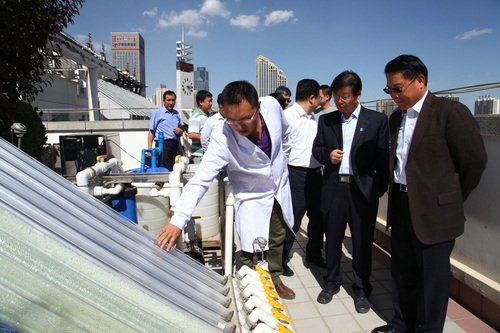 ©UNIDO, 2014-DG visits UNIDO Solar Energy Center in Lanzhou, China (UNIDO, 2014).
©UNIDO, 2014-DG visits UNIDO Solar Energy Center in Lanzhou, China (UNIDO, 2014).
The world's biggest investor in renewable energy. The largest installed capacity of wind and solar power of any country. The fastest installation rate of new renewable energy generation.
The number of world records China is capturing in cleantech keep adding up as the country pushes forward with its plans to de-carbonize its economy. One area where China hasn't been setting any records, however, is in its ability to integrate all the renewable energy it produces with its electricity grid. In 2015, 15 percent of China's wind energy and 9 percent of its solar energy was "curtailed," meaning that wind and solar energy production had to shut down because the electricity grid was not able to absorb the power that would have been generated (by contrast the curtailment rate in Europe is closer to one to two percent). This is a serious challenge for China, signifying that much of the clean energy that should be replacing coal-generated power is going to waste. In an attempt to solve this, China's National Energy Administration (NEA) last month released a new nine-point work plant (Chinese) to help the country rectify this issue.
This issue is especially acute in China's northern regions. Provinces like Jilin, Gansu, Xinjiang, and Inner Mongolia are endowed with enviable levels of wind and solar resources, but the inability of the electricity grid to handle this supply of clean energy is leading to sky-high curtailment rates. In 2015, Jilin, Gansu, and Xinjiang had wind curtailment rates of 32 percent, 39 percent, and 32 percent respectively (Chinese), meaning that about a third of the available wind energy in these provinces was never produced. Curtailment rates for solar were not much better, with Gansu and Xinjiang recording solar curtailment rates of 31 percent and 26 percent respectively (Chinese). The NEA hopes to solve this issue by improving the flexibility of China's electricity grid, as well as by identifying new uses for this windfall of carbon-free electricity.
The first solution, grid flexibility, is one that is being recognized globally as a key component of renewable energy integration. The NEA's announcement acknowledges that, in modern electricity systems where energy comes from variable resources like the sun and wind, it's important that the electricity grid be designed to deal with this variability. In order for the power grid to operate properly, the amount of electricity that is supplied to the grid must perfectly match the demand (load) on the system. Renewable energy poses a challenge to the grid when shifts in wind speeds or sunlight levels create short-term fluctuations that throw off the supply-demand balance. When this happens, the grid needs other energy generators to respond to these fluctuations by increasing or decreasing their power supply.
This load-following response is a type of "ancillary service" to the grid, and the NEA's new work plan supports development of this ancillary service by increasing the compensation that generators can receive for providing it. It also promotes the use of two relatively cleaner technologies to provide ancillary services: natural gas-fired generation and pumped hydro storage. Both of these technologies are under-utilized in China but can provide this load-following service more cleanly and efficiently than coal-fired power plants, which are currently the country's go-to choice.
These solutions allow utilities to balance the energy load by adjusting the supply of electricity, but another approach to achieving this balance is to adjust energy demand. This can be done using demand response (DR), a technique in which the utility requests short-term demand reductions from participating energy users, usually in exchange for a financial incentive. DR can provide load-following ancillary services more cleanly, and typically more cheaply, than thermal coal plants. NRDC has long supported the increased use of DR in China, viewing it as not just a more environmental way to stabilize the grid but also as a resource to improve renewable energy integration. However, China currently lacks a mechanism under which DR providers can compete against generators to provide these services, which has retarded its development.
The NEA's new announcement shows some progress on this front. The work plan released in February promotes the use of market mechanisms to decide which grid service provider will supply load-following ancillary services. This could potentially allow solutions like DR to compete against traditional generators in ancillary service markets. It will still take time to reach this point; at the moment, China's regulations don't include DR in its definition of ancillary services. The new announcement by the NEA bodes well for generators that provide ancillary services, but more clarity and support are needed to enable flexible demand-side resources like DR to play a role in helping integrate renewable energy.
Improved flexibility is an important step forward in helping the grid manage variable renewable energy, but another key component is having somewhere for that energy to go once it's on the grid. To do this, the NEA is developing new uses for renewable energy produced in China's northern provinces. One promising approach is to use wind energy to help service the region's extensive heating needs. Several places in Jilin and Inner Mongolia are exploring the use of wind-generated electricity to provide building heating, especially during the nighttime when heat is most needed and the supply of wind energy is often highest. Since most heat in these regions is currently generated by coal, this would also help reduce China's air pollution and carbon emissions. The NEA announcement also encouraged the creation of direct markets for renewable energy, empowering renewable energy generators to sell electricity directly to those who need it and providing an additional outlet for their electricity if the grid is unable to accept it all.
The two solutions that the NEA is pushing - improved grid flexibility and new uses for renewable energy - are solutions that NRDC's work is exploring as well. NRDC's China office is currently developing a project that will test the potential for electric vehicles (EVs) to take part in DR programs. The idea is for electric utilities to improve renewable energy integration by coordinating EV charging with conditions on the grid. Electric vehicles are an ideal technology for utilities to work with for two reasons: first, they can store a lot of energy, which means that if they're charged when surplus renewable energy is available (such as during the night when wind power is abundant but energy demand is low), then they can hold onto that energy for later use; and second, they usually have some flexibility in when they are charged, so DR providers can adjust their charging times in order to match electricity demand with fluctuations in energy supply.
NRDC has launched a demonstration EV-DR pilot project in Shanghai, taking advantage of the city's growing electric vehicle fleet. Although it's far from China's northern provinces where renewable energy integration issues are the most severe, the lessons learned from the project will be applicable anywhere in China. The goal is that, by scaling up these types of pilot projects, utility-managed EV charging can assist China's power sector to move towards the goals outlined in the NEA's work plan: a flexible electricity grid and a diverse set of uses for China's renewable energy resources. This work plan sees China building on past success in clean energy development, indicating that China is taking another step forward in this direction.
(This post was co-authored by my colleague Princeton in Asia Fellow Colin Smith.)


